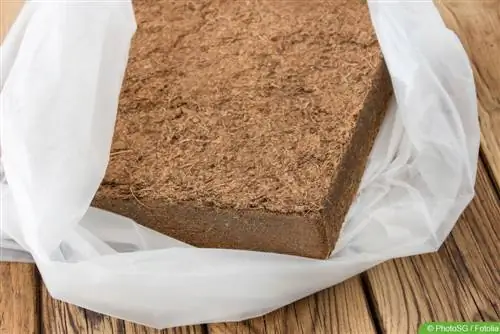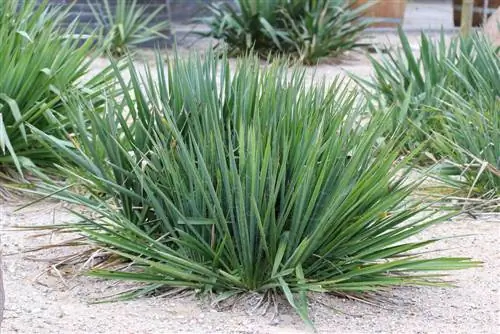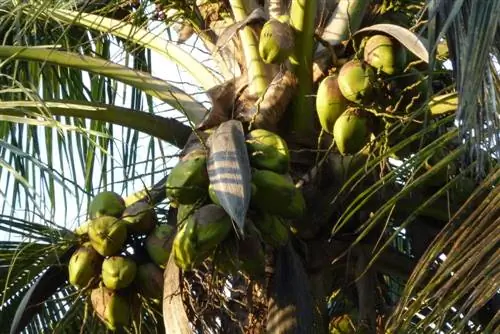- Author admin [email protected].
- Public 2023-12-17 03:39.
- Last modified 2025-01-24 12:45.
It is also called the “tree of heaven”: the coconut palm. With its lush green leaves, it reminds you of summer, beaches and enjoyment. And everyone would like to bring these feelings of exhilaration into their own four walls. Anyone who knows how to properly care for this beautiful plant will soon be able to enjoy its unique appearance.
Sowing the coconut palm
In nature, palm trees can reproduce beyond the sea. The coconut floats over the water for long distances until it reaches land. Once there, it takes almost 12 months to root itself in one location and form germs. If you want the coconut palm to beautify your room at home, it should be noted when sowing that there are two ways to plant a palm tree. You can buy pre-germinated or germinable nuts. All measures at a glance:
- Coconut germinates inside
- three points on one side of the nut are the germ holes
- only one shoot per plant comes out of one of the three holes
- Remove fiber sheath
- Put the nut with the bare shell in hot water
- make sure the temperature is right (25 °C)
- After swelling, leave the nut in a warm place for two months
- then place in moist substrate
- after two months the nut should germinate
- the root grows through the shell
- Time to plant the nut with the shell half in a pot with moist substrate
- with pre-sprouted nut some steps can be skipped
Proper substrate for coconut palms
The coconut palm is a tropical tree that prefers a permeable, slightly acidic environment. Older palm trees are content with a mixture of pure garden soil and sand. The younger plants that are in the strong growth phase or in cultivation are a little more demanding. If these requirements are not observed, the young palm trees will quickly die and the work of sowing will be in vain.
Substrate should be permeable
- pH value is slightly acidic
- young plants need a compost-based soil mixture
- Addition of some sharp sand and a small amount of gravel, lava granules or expanded clay pieces
- Peat or humus do not ensure sufficient ventilation, therefore not usable
- older coconut palms also thrive in a mixture of garden soil and sand
- Substrate should always be slightly moist
Suitable location for coconut trees
The Cocos nucifera is a sun worshipper. It needs up to 12 hours of light per day to develop optimally. Light intensity is also fundamental to the he alth of the plant. In our latitudes, this level of light can hardly be managed by the local weather conditions. Therefore the difference must be artificial. Young plants prefer partial shade during cultivation, but like older palms, they are also sensitive to heat. The ambient temperature must never fall below 18 °C. 70 to 80 percent humidity is a must for optimal growth and he alth of the coconut palm.
- advisable is a sunny place
- 12 hours of light per day are necessary
- Compensate the difference with artificial lighting
- Light intensity can be measured using a lux meter
- Growing plants also like partial shade
- The palm tree dies below 18°C
- optimal humidity is 70 to 80 percent
- humidifiers or spray bottles are helpful
Attention
Brown leaves are a sign of too little heat, light or water!
Watering and fertilizing the holiday tree
Coconut palms also take work. The plant needs sufficient water from May to September. Liquid fertilizer should be applied every two weeks from spring to the end of summer. The half of the nut that should be sticking out of the ground should not be left in the water for too long. It is also important that the water should be at a comfortable temperature. And the palm tree also benefits in the winter months if the soil is kept moist. A few important tips for watering and fertilizing summarized:
- from May to September the palm tree needs a lot of water, at a comfortable temperature
- liquid fertilizer every two weeks
- add water when the substrate dries slightly on the surface
- do not use water rich in lime
- from October you can water less
- Caution: Plant must not be permanently in water
Repotting the Cocos nucifera
In the wild, coconut palms can reach a height of 30 meters. In the living room or winter garden it will be two to three meters. If the first roots can be seen on the surface, it is time to buy the palm a larger pot that is a few centimeters larger. The steps in detail:
- add fresh palm soil to the larger bucket
- Carefully remove the plant from the old pot
- Attention: Palm trees have vertical taproots - do not damage them!
- Plant half of the nut in a new pot
- Press the soil well
- water and fertilize well
Cutting palm trees
- Pruning the coconut palm is not necessary
- certain varieties can tolerate it
- most varieties cannot tolerate being cut back
Extra caution
Palm trees have the so-called “palm heart” in the middle, which must not be trimmed.
Overwintering the tropical tree
Light and warmth are important all year round. Therefore, well-air-conditioned rooms should be a prerequisite in order to give the coconut palm an optimal winter period. Although it is in the resting phase, only needs to be watered once a week and does not need any fertilizer, the high light intensity in the winter months is also important.
- Light and warmth are still important
- Temperature must also be at least 18 °C
- Palm tree is in the dormant phase, so no fertilizer needed
- 1,000 to 2,000 lux is necessary to keep them he althy
- Plant only needs to be watered once a week
With perfect care, coconut palms can bring a touch of holiday into our rooms for two to three years and can even counteract the dreary weather with their typical feathery fronds.
What you should know about the coconut palm in brief
Despite the rather unfavorable climatic conditions here in Germany, it is still not entirely impossible to keep a coconut palm without it immediately dying again. It's all about proper care. One of the most important criteria is of course the location. When choosing one, you should definitely make sure that it is always a bright and well-tempered place. The coconut palm needs a lot of light all year round, and in the areas where the coconut palm is native, it also finds this. The brighter the location (preferably in the blazing sun), the faster the growth will progress. A bright location is also important for the appearance of the coconut palm, or rather its leaves. The leaves only get their typical feather-like appearance if they can grow consistently in a very bright, sunny environment.
Another important criterion for good growth of Cocos nucifera is the temperature. This should be as constant as possible around 18°C. Lower temperatures are noticeable in that the plant stops growing or even dies. If the temperatures allow it in summer, you can also put your coconut palm outside. But it shouldn't be much colder than 18° C at night.
Conclusion
A coconut palm is only really suitable as a houseplant if it has a bright, well-tempered location all year round. Of course, even under optimal conditions, you shouldn't assume that in our latitudes you will eventually be able to have a fully grown, thirty-meter-high coconut palm in your home.






